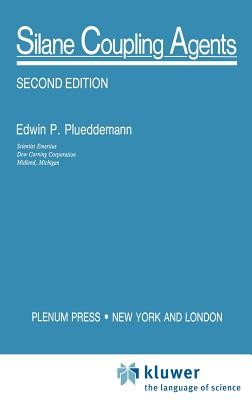
- We will send in 10–14 business days.
- Author: E P Plueddemann
- Publisher: Springer
- Year: 1991
- ISBN-10: 0306434733
- ISBN-13: 9780306434730
- Format: 16.1 x 23.8 x 2.4 cm, hardcover
- Language: English
- SAVE -10% with code: EXTRA
Reviews
Description
* Much progress has been made in the last 8 years in understanding the theory and practice of silane coupling agents. A major advance in this direction was the measurement of true equilibrium constants for the hydroly- sis and formation of siloxane bonds. Equilibrium constants for bond reten- tion are so favorable that a silane coupling agent on silica has a thousandfold advantage for bond retention in the presence of water over an alkoxysilane bond formed from hydroxy-functional polymers and silica. In practice, the bonds of certain epoxies to silane-primed glass resist debonding by water about a thousand times as long as the epoxy bond to unprimed glass. Oxane bonds of silane coupling agents to metal oxides seem to follow the same mechanism of equilibrium hydrolysis and rebonding, although equilibrium constants have not been measured for individual metal-oxygen- silicon bonds. This suggests, however, that methods of improving bond retention to glass will also improve the water resistance of bonds to metals. of standard coupling agents with a hydrophobic silane or one Modification with extra siloxane cross-linking have improved the water resistance of bonds to glass and metals another hundredfold over that obtained with single coupling agents.
EXTRA 10 % discount with code: EXTRA
The promotion ends in 13d.09:14:30
The discount code is valid when purchasing from 10 €. Discounts do not stack.
- Author: E P Plueddemann
- Publisher: Springer
- Year: 1991
- ISBN-10: 0306434733
- ISBN-13: 9780306434730
- Format: 16.1 x 23.8 x 2.4 cm, hardcover
- Language: English English
* Much progress has been made in the last 8 years in understanding the theory and practice of silane coupling agents. A major advance in this direction was the measurement of true equilibrium constants for the hydroly- sis and formation of siloxane bonds. Equilibrium constants for bond reten- tion are so favorable that a silane coupling agent on silica has a thousandfold advantage for bond retention in the presence of water over an alkoxysilane bond formed from hydroxy-functional polymers and silica. In practice, the bonds of certain epoxies to silane-primed glass resist debonding by water about a thousand times as long as the epoxy bond to unprimed glass. Oxane bonds of silane coupling agents to metal oxides seem to follow the same mechanism of equilibrium hydrolysis and rebonding, although equilibrium constants have not been measured for individual metal-oxygen- silicon bonds. This suggests, however, that methods of improving bond retention to glass will also improve the water resistance of bonds to metals. of standard coupling agents with a hydrophobic silane or one Modification with extra siloxane cross-linking have improved the water resistance of bonds to glass and metals another hundredfold over that obtained with single coupling agents.


Reviews